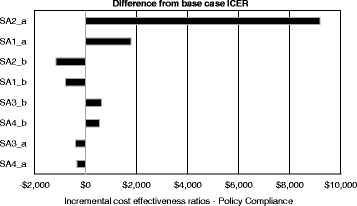Economic analysis of three interventions of different intensity in improving school implementation of a government healthy canteen policy in Australia: costs, incremental and relative cost effectiveness
- PMID: 29558931
- PMCID: PMC5859495
- DOI: 10.1186/s12889-018-5315-y
Economic analysis of three interventions of different intensity in improving school implementation of a government healthy canteen policy in Australia: costs, incremental and relative cost effectiveness
Abstract
Background: No evaluations of the cost or cost effectiveness of interventions to increase school implementation of food availability policies have been reported. Government and non-government agency decisions regarding the extent of investment required to enhance school implementation of such policies are unsupported by such evidence. This study sought to i) Determine cost and cost-effectiveness of three interventions in improving school implementation of an Australian government healthy canteen policy and; ii) Determine the relative cost-effectiveness of the interventions in improving school implementation of such a policy.
Methods: An analysis of the cost and cost-effectiveness of three implementation interventions of varying support intensity, relative to usual implementation support conducted during 2013-2015 was undertaken. Secondly, an indirect comparison of the trials was undertaken to determine the most cost-effective of the three strategies. The economic analysis was based on the cost of delivering the interventions by health service delivery staff to increase the proportion of schools 'adherent' with the policy.
Results: The total costs per school were $166,971, $70,926 and $75,682 for the high, medium and low intensity interventions respectively. Compared to usual support, the cost effectiveness ratios for each of the three interventions were: A$2982 (high intensity), A$2627 (medium intensity) and A$4730 (low intensity) per percent increase in proportion of schools reporting 'adherence'). Indirect comparison between the 'high' and 'medium intensity' interventions showed no statistically significant difference in cost-effectiveness.
Conclusions: The results indicate that while the cost profiles of the interventions varied substantially, the cost-effectiveness did not. This result is valuable to policy makers seeking cost-effective solutions that can be delivered within budget.
Keywords: Childhood obesity; Economic evaluation; Healthy eating policies; Implementation strategies.
Conflict of interest statement
Ethics approval and consent to participate
Approval to conduct the study was obtained from the Hunter New England Human Research Ethics Committee (no. 06/07/26/4.04), The University of Newcastle Human Research Ethics Committee (Approval Number H-2008-0343) as well as the NSW Department of Education and the relevant Catholic Schools Offices.
Consent for publication
Not applicable
Competing interests
The authors declare that they have no competing interests.
Publisher’s Note
Springer Nature remains neutral with regard to jurisdictional claims in published maps and institutional affiliations.
Figures
References
-
- GBD 2013 Risk Factors Collaborators Global, regional, and national comparative risk assessment of 79 behavioural, environmental and occupational, and metabolic risks or clusters of risks in 188 countries, 1990–2013: a systematic analysis for the global burden of disease study 2013. Lancet. 2015;386:2287–2323. doi: 10.1016/S0140-6736(15)00128-2. - DOI - PMC - PubMed
-
- Australian Institute of Health and Welfare 2014. Australia’s health 2014. Australia’s health series no. 14. Cat. No. AUS 178. Canberra: AIHW. 2014.
-
- Magarey AMDL, Boulton TJ. Prevalence of overweight and obesity in Australian children and adolescents: reassessment of 1985 and 1995 data against new standard international definitions. Med J Aust. 2001;174(11):561–564. - PubMed
Publication types
MeSH terms
LinkOut - more resources
Full Text Sources
Other Literature Sources




